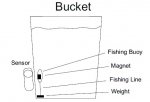One of the things I do is raise snakes, which also means raising snake-food (Rats and mice).
We have two racks with rodents, and each rack has a 5-gallon bucket with water to supply the wee things with water.
One of the things I'd like to do as a project is measure the water levels and connect to a PC to read measurements and log levels.
I'm not worried about the interfacing or the PC software part, I'm a programmer.
But what I'm not sure about is measuring the water level.
Does anyone know if you can use the classical ir-measuring (Using something like this: http://www.digikey.com/product-detail/en/28995/28995-ND/3523692?WT.mc_id=PLA_3523692 ), placed on the lid, facing down, to measure the distance to the surface of the water.
I've also thought about a pressure sensor placed on the bottom to measure the relative weight of the water (Not sure if that would work or not).
Those are the two ideas I think would potentially work best, but since I'm new to electronics I figured I'd ask, maybe someone has a better idea or has already solved this problem somehow else.
We have two racks with rodents, and each rack has a 5-gallon bucket with water to supply the wee things with water.
One of the things I'd like to do as a project is measure the water levels and connect to a PC to read measurements and log levels.
I'm not worried about the interfacing or the PC software part, I'm a programmer.
But what I'm not sure about is measuring the water level.
Does anyone know if you can use the classical ir-measuring (Using something like this: http://www.digikey.com/product-detail/en/28995/28995-ND/3523692?WT.mc_id=PLA_3523692 ), placed on the lid, facing down, to measure the distance to the surface of the water.
I've also thought about a pressure sensor placed on the bottom to measure the relative weight of the water (Not sure if that would work or not).
Those are the two ideas I think would potentially work best, but since I'm new to electronics I figured I'd ask, maybe someone has a better idea or has already solved this problem somehow else.

